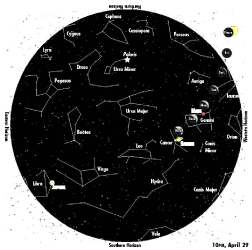 |
Sky Watch
by J. Alex Knoll
|
Reflections from Space
Reflected sunlight illuminates the dark places in our night sky
Thursday’s new moon provides a dark setting for skywatchers this week. Even as the moon waxes, it will set at most a few hours after sunset, around 8pm this week.
Late, moonless spring evenings offer some of the best opportunities to catch a glimpse of the other-worldly zodiacal light. This faint, whitish triangle appears from the point of sunset at the horizon and extends along the ecliptic. Look to the west once the sky is truly dark for this false dawn, caused by sunlight reflecting off countless bits of interplanetary dust. The light from this dust accounts for 60 percent of the total skylight on a moonless night. Even so, the zodiacal light is so faint that the least light pollution will wash it from view.
The new waxing moon offers a much easier sight this week: earthshine. Perhaps you’ve noticed with either an early-waxing moon or a late-waning moon that the dark part of the crescent is not missing but appears as a grey silhouette. Sunlight reflected from the opposite side of earth casts a dim light on the shaded lunar disk. The cloudier our planet’s skies, the more earthshine cast upon the moon’s shadowed face. So if you’re seeing a lot of earthshine, chances are it’s quite overcast in China, Australia and the rest of the Far East.
Monday marks the second of the year’s four cross-quarter days, which fall midway between solstice and equinox. Long ago, Europe’s pre-Christian Gaelic and Celtic people celebrated this day as Beltane, the bonfire festival, which marked the peak of spring blooming. The holiday survives today as May Day, which we celebrate by decorating poles and filling baskets with flowers.
